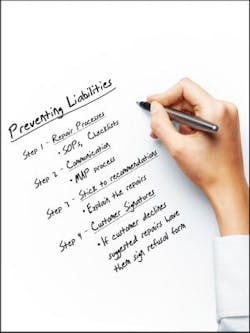Sometimes, you simply have to learn the hard way.
That’s how Jim Saeli puts it. As a shop owner for more than 12 years, Saeli had only one legal issue in his entire career. And it only takes one, he says, to change the way you handle customers.
“We had a customer come in—one of our really good, regular customers—for a job that required a new radiator, water pump and a whole bunch of other stuff,” Saeli remembers, “and we get a call later that, while he was driving up to college, the engine blew.”
Saeli’s shop was in New Jersey. The customer was now in Massachusetts, and the vehicle was brought into the dealership in the area. The dealer told the customer that the problem occurred from a hose clamp that was left loose, pinning Saeli’s shop for negligence.
To make a long story a bit shorter: Saeli wound up winning a court case from the ensuing lawsuit because it was determined the customer drove more than 80 miles with the temperature gauge buried at unsafe levels—a fairly lucky break, Saeli says. And, although he won the case, he lost a good customer.
Saeli says it’s a lesson all shops should learn; albeit, in an easier way than he did.
“You have to know how to protect yourself,” he says, “and you have to know what to do when these situations come up.”
Saeli, now a consultant for Management Success!, says liability issues aren’t something your shop can afford to overlook. And the fact is, a great deal of shops don’t know what they are actually liable for and what they can do to prevent getting caught in costly litigation.
What are you liable for?
Joseph Henmueler was a shop manager with Midas for more than 15 years, and he saw his fair share of liability issues with surrounding shops. Now, as the director of administration for the Automotive Maintenance and Repair Association (AMRA), he works directly with both independent shops and major repair franchises on preventing these issues through AMRA’s Motor Assurance Program (MAP).
Henmueler says a shop’s degree of liability for repairs can vary depending on jurisdiction.
“The problems tend to really come in when someone was injured, even fatally injured, in a crash,” he says, “or it can be as simple as the car blowing out again when it should’ve been fixed.
“The point is that you are going to be held liable for the work you do, or ‘should’ve’ done.”
And in some cases, Henmueler says, a written and signed invoice may not even hold up.
“We’ve seen it,” he says of those at AMRA, “where the courts will say, ‘You’re the professional, you’re the expert, you should not let them out of your door with an unsafe car.’ And the fact is, they’re probably right. It’s your responsibility, and you can’t do mediocre work.”
There are two ways to handle liability issues: The first is to work to prevent them before they even occur, and the second is to react and fight it when they do come up.
Preventing Problems
From the perspective of a repair facility, MAP was created to help protect the business against any deficiencies in their repair processes.
And that’s the key word here: processes.
“That’s what it takes to prevent your shop from running into tough situations,” Henmueler says. “If you have the standard operating procedures in place, and you have the correct documentation in place, then it’s unlikely a problem will occur.”
Step 1: Repair Processes
Whether it’s brake systems, rebuilding an engine or simply changing the oil, Saeli and Henmueler say shops need recorded, specific and thorough SOPs to handle each job.
Henmueler suggests a literal checklist for technicians, like the ones used in the MAP program, that force technicians to check every part of a vehicle system when doing work.
“You take this checklist for, say, a brake system, and you look at every component in the system and mark whether it’s OK or it needs service,” he says. “You’ll check the hydraulics, brake lights, parking brake, take off all four wheels for inspection, and record everything. And that could be just for replacing the brake pads.
“What you’re doing is ensuring that you never miss something in a system that may be worn.”
Step 2: Communication Processes
Now, a shop can do all the correct repairs, checks and inspections and still be in trouble if the customer doesn’t fully understand everything you did and everything you’re suggesting they do, Saeli says.
“The customer has to be in on the process,” he says. “They need to understand everything that’s going on, and the severity of those issues.”
In the MAP process, repairers identify all issues with a system and mark them as either required work (item is missing, no longer meets design specifications or no longer performs intended purpose) or suggested/optional items (all others that don’t put the customer at risk).
Then, the shop needs to communicate all this information and ensure that the customer understands the differences and what they need to do to drive away safely.
Step 3: Stick to Your Recommendations
The customer always has the option to decline services, because as Saeli puts it, all a shop can do is recommend and request the repairs be performed.
Still, that doesn’t mean a shop can back down from its findings.
“If they decline the work or want you to work around it, you simply can’t afford to do that,” Henmueler says. “You can’t tell them the front and back brakes are both required items, and they only want to do the front, right now, because of money issues. You might feel like you’re doing them a favor, but all you’re doing is putting them at risk.”
Henmueler says that shops should not work on any part of a system if all required repairs are not going to be performed. Simply put: It puts your shop at risk of future litigation.
“It’s tough to do, but you can’t afford to only do half the necessary work,” he says.
Keep in mind, Henmueler says, that “required” repairs are necessary to make the vehicle safe to drive. If customers turn down required repairs it could be dangerous to let them drive away.
And it can put your shop at risk.
“You have to tell the customer that you can’t work on the vehicle then, and ask them where they would like it towed,” he says of those rare,
extreme situations.
Step 4: Get Signatures
Whether the customer declines or agrees to the service, get their signature confirming it on an invoice or an agreement form. Although it won’t necessarily be your savior in a lawsuit, having thorough documentation will always be a powerful tool in defending your shop down the road, and it lets the customer know that you’re covering all your bases.
Reacting to Problems
Even if your shop does everything to prevent a liability issue before working on a vehicle, Saeli says, problems can still incur from the work you did—or the customer’s perception of that work. You can still get “those certain types of people who are looking for someone to blame,” Saeli says.
When problems do occur, Saeli says, it’s how you react to the situation that will ultimately determine your liability. And there are a few simple things you can do—things Saeli learned from his own experience—to avoid legal issues.
Calm the customer
Usually, Saeli says, you can sense when a situation is going to escalate further than it needs to. He suggests trying to head off any issues before they get out of hand.
“You might have to apologize and eat a repair, even if you know it’s not your fault,” he says. “Calming the person down and eventually keeping them as a customer—that makes up for the cost you might have for doing that repair for free. I’m not going to lose a lifelong customer over a 20-buck part or a few hours of labor. It’s not worth it.”
If it escalates
This is where your documentation and procedures may save you, both Henmueler and Saeli say. If you can prove how you handle repairs and have the documentation for the specific work, you have “both legs to stand on” when arguing your case, Henmueler says.
After it’s over
Saeli stresses the importance of learning from the situation that occurred—and making the necessary changes to your shop’s processes to reflect that.
In the situation at his shop, Saeli made two crucial changes: His shop began checking every item in a system, and they put in a new policy that if a car breaks down after being in their shop, they make sure it comes back to them.
“If I would’ve paid for the customer’s vehicle to be towed all the way back to us—about 80 miles—and fixed it ourselves, we would’ve prevented the entire situation,” he says.
“What’s worth more to you: the cost of the tow, or the loyalty of that customer?
“It’s all about protecting your shop and protecting your customers.”

